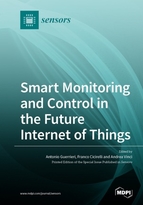Smart Monitoring and Control in the Future Internet of Things
A special issue of Sensors (ISSN 1424-8220). This special issue belongs to the section "Internet of Things".
Deadline for manuscript submissions: closed (31 May 2019) | Viewed by 58646
Special Issue Editors
Interests: Internet of Things; wireless sensor and actuator networks; WSN frameworks; multi agent systems
Special Issues, Collections and Topics in MDPI journals
Interests: Software Engineering tools and methodologies for the modeling; analysis and implementation of complex time-dependent systems; agent-based systems; distributed simulation; parallel and distributed systems; real-time systems; workflow management systems; Internet of Things and cyber-physical systems; smart cities; Petri Nets; Timed Automata and the DEVS formalism
Special Issues, Collections and Topics in MDPI journals
Interests: Internet of Things and Cyber-Physical Systems; definitions of platforms and methodologies for the design and implementation of cyber-physical systems; distributed algorithms for the efficient management of urban facilities; swarm intelligence and peer-to-peer techniques; and Data Mining; Ambient Intelligence; edge computing; GPU computing; smart cities
Special Issues, Collections and Topics in MDPI journals
Special Issue Information
Dear Colleagues
The Internet of Things (IoT) and related technologies have the promise of realizing pervasive and smart applications which, in turn, have the potential of improving the quality of life of people living in a connected world. According to the IoT vision, all the things can cooperate among them and can be managed from anywhere via the Internet, to allow tight integration between physical and cyber worlds, thus improving efficiency, promoting usability, and opening up new application opportunities. Nowadays, IoT technologies are successfully exploited in several domains providing both social and economic benefits. The realization of the full potential of the next generation of the Internet of Things still needs further research efforts concerning, for instance: the identification of new architectures, methodologies, and infrastructures dealing with distributed and decentralized IoT systems; the integration of the IoT with cognitive and social capabilities; the enhancement of the sensing–analysis–control cycle; the integration of consciousness and awareness in IoT environments; and the design of new algorithms and techniques for managing IoT big data.
This Special Issue aims at covering state-of-the-art and advancements in technologies, methodologies and applications for IoT, together with emerging standards and research topics which would lead to realization of the Future Internet of Things.
Dr. Antonio Guerrieri
Dr. Franco Cicirelli
Dr. Andrea Vinci
Guest Editors
Manuscript Submission Information
Manuscripts should be submitted online at www.mdpi.com by registering and logging in to this website. Once you are registered, click here to go to the submission form. Manuscripts can be submitted until the deadline. All submissions that pass pre-check are peer-reviewed. Accepted papers will be published continuously in the journal (as soon as accepted) and will be listed together on the special issue website. Research articles, review articles as well as short communications are invited. For planned papers, a title and short abstract (about 100 words) can be sent to the Editorial Office for announcement on this website.
Submitted manuscripts should not have been published previously, nor be under consideration for publication elsewhere (except conference proceedings papers). All manuscripts are thoroughly refereed through a single-blind peer-review process. A guide for authors and other relevant information for submission of manuscripts is available on the Instructions for Authors page. Sensors is an international peer-reviewed open access semimonthly journal published by MDPI.
Please visit the Instructions for Authors page before submitting a manuscript. The Article Processing Charge (APC) for publication in this open access journal is 2600 CHF (Swiss Francs). Submitted papers should be well formatted and use good English. Authors may use MDPI's English editing service prior to publication or during author revisions.
Keywords
- Internet of Things and Cyber–Physical Systems
- Architectures, Methodologies, and Infrastructures for IoT Systems
- Cognitive and Social Internet of Things
- Future Internet of Things
- Smart Computing Technologies and Applications
- Networked Sensing and Control
- Standards and Protocols for IoT
- Cloud, Fog, and Edge Computing for IoT
- Big Data Analytics and Ambient Intelligence
- Consciousness, Awareness, and Artificial Intelligence in the IoT









